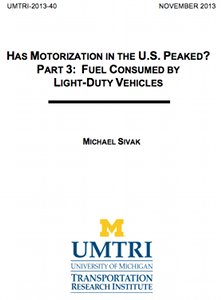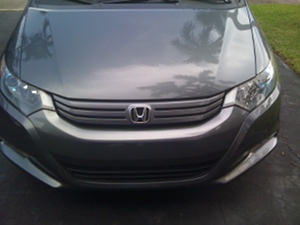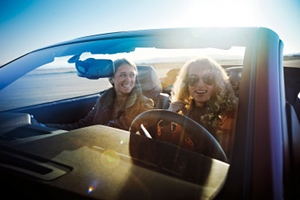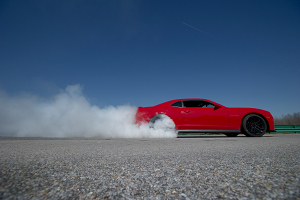Posted by Elena del Valle on November 18, 2013

U.S motorization study by Michael Sivak
In 2011, based on the most recent data available, the average driver in the United States consumed 585 gallons of fuel or 1,033 gallons per household. Recent studies indicate that Americans, in general, own fewer light-duty vehicles, drive each of them less, and consume less fuel than in past years.
According to the results of a study (one of three on the subject conducted) released this month, researchers believe fuel consumption rates per person, per licensed driver, per household, and per registered vehicle and distance-driven rates peaked in 2003 or 2004, before the ongoing economic downturn.
By 2011, they had decreased by 13 percent to 17 percent. The researchers believe the long term peak was reached around 2003 or 2004.
They concluded Americans drive fewer light-duty vehicles, defined as cars, pickup trucks, SUVs, and vans; they drive each of them less, and consume less fuel. They also estimate that current fuel consumption rates are lower than they were in 1984 when they began to track the information.
The 17-page report, titled Has Motorization in the U.S. Peaked? Part 3: Fuel consumed by light-duty vehicles was authored by Michael Sivak, director, Sustainable Worldwide Transportation, University of Michigan Transportation Research Institute. Earlier this year, he published two reports in which he looked at recent trends in the numbers of registered light-duty vehicles in the United States and the corresponding distances driven.
Posted by Elena del Valle on July 25, 2012

Fewer young people are obtaining a driver’s license, according to researchers at University of Michigan Transportation Research Institute
Photo: HispanicMPR.com
Research conducted by Michael Sivak and Brandon Schoettle of the University of Michigan Transportation Research Institute, Ann Arbor, Michigan indicates again that fewer young people, compared to previous decades, are obtaining a driver’s license. The researchers reviewed driver license and general population information from the Federal Highway Administration and the United States Census Bureau to find that the trend they had identified in the past continues. As an example, they point to drivers 19 years of age. Their findings indicate 87.3, 75.5, and 69.5 percent of these individuals had a driver’s license in 1983, 2008, and 2010 respectively.
“The most significant aspect of our findings is that the trend that we observed in a previous study is continuing,” said Sivak by email. “Specifically, young and middle-aged persons are less likely to get a driver’s license now than were the corresponding age groups 30 years ago. We think that the availability of electronic communication has a lot to do with this trend.”
Earlier this year (see Older adults more likely drivers than in past decades), after examining data for 1983 to 2008 in the United States and 14 other countries they concluded there was a noticeable decrease in the percent of young people obtaining a driver’s license and an increase in the percent of older people with one. They have since examined additional data in the United States through 2010 that indicates the trend continues for young people and that there is a reduction in the proportionate number of driver’s licenses across age groups.
They still believe the trend relates inversely to the continued increase in internet usage. They concluded that the more people rely on the internet for contact the less they require in person contact.
It’s unclear whether the trend applies to all market segments. Hispanics which as a market are younger than the general market may be affected. A Ford Motor Company representative when asked about the trend responded negatively.
“For Hispanic consumers cars are a symbol of freedom, accomplishment and status,” said Alvaro Cabal, manager, Multicultural Communication, Ford Motor Company.
Except in cities with efficient mass transportation systems like New York and Washington, D.C., the research findings are not in evidence in car buying behavior, he explained by phone. He went on to say that since the 2008 recession when car sales dropped the company has experienced a steady increase in car purchases, especially among 18 to 45 year old buyers.
Posted by Elena del Valle on May 9, 2012

Young women drive a Ford Mustang convertible
Photos: Ford, General Motors
Sellers of products or services offline in old style brick and mortar offices and stores, especially those targeting a young demographic, may be interested to know that fewer young people have a driver’s license today than did their counterparts in the early 1980s, according to a University of Michigan study released December 2011. That means young customers without a driver’s license instead of self driving to visit an office or store have to rely on other means such as mass transportation, online shopping, and friends and family who have a car and drive.
The driver’s license study findings seem to match the declining sales of used cars, traditionally bought by young adults, young couples with children at home and married couples with adult children at home (they spend 72 percent more on average*). Average household spending on used cars dropped 30 percent between 2000 and 2007, according to *Best Customers Demographics of Consumer Demand.
While only 22 percent of drivers today are teenagers or in their twenties in 1983, one third of licensed drivers in the country were under 30 years old. That year, more than half of people with driver’s licenses were under 40 years of age and today less than 40 percent of drivers are under 40. The study authors did not analyze information by ethnicity or race.
Emerging market segments are well represented in young demographics. At the same time, Asian, Hispanic and black consumers spend more than the average household on mass transportation and spend less than the average household on transportation in general (Household Spending Who Spends How Much on What).
The researchers in Michigan believe there is a link between the decrease in driver’s license owners and the popularity of texting and electronic devices, activities and products that are popular among young Americans. Emerging market members tend to over index in their consumption of such products and electronic communication methods.

Sports cars like the GM Camaro 2012 may inspire people to get a driver’s license
“It is possible that the availability of virtual contact through electronic means reduces the need for actual contact among young people,” said Michael Sivak, research professor at the U-M Transportation Research Institute. “Furthermore, some young people feel that driving interferes with texting and other electronic communication.”
Sivak and Brandon Schoettle, a University of Michigan Transportation Research Institute colleague, examined the changes from 1983 to 2008 in the percentage of persons with permits to drive by age in a study in the journal Traffic Injury Prevention. They believe that there are fewer young people among all of today’s licensed drivers, and that young drivers are a smaller portion of their age group as a whole, compared to 1983.
That year, 87 percent of 19-year-olds had a permit to drive while in 2008 only 75 percent did. Likewise 80 percent of 18-year-olds had a license in 1983 and only 65 percent had one in 2008; 69 percent of 17-year-olds had a license in 1983 but only 50 percent did in 2008; and 46 percent of 16-year-olds had one in 1983 but only 31 percent did in 2008.
In 2008, people 70 and older were part of the largest group of drivers on the road, representing more than 10 percent of all drivers and a slightly higher percentage than those in their 40s or 50s. By that year licensed drivers as a percentage of their age group population had increased for all groups over 45 years of age since 1983. In 2008, 94 percent of those aged 65 to 69 and 78 percent of those 70 and older had drivers licenses, up from 79 percent and 55 percent, respectively, in 1983.
Some believe the recession, the cost of owning a car, migration trends toward large urban centers and the popularity of social media may account for some of the decline in driver’s permits among young Americans.
Looking internationally Sivak and Schoettle identified a similar pattern of a decrease in young drivers in seven countries and a contrary pattern in another seven countries in a subsequent study released this year, Recent Changes in the Age Composition of Drivers in 15 Countries. They concluded in their analysis that “higher societal wealth, older population in general, and higher proportion of population living in megacities were each associated with higher licensure rates among young persons.” In that study, they found that the more internet users present the lower licensure rates among youth.













